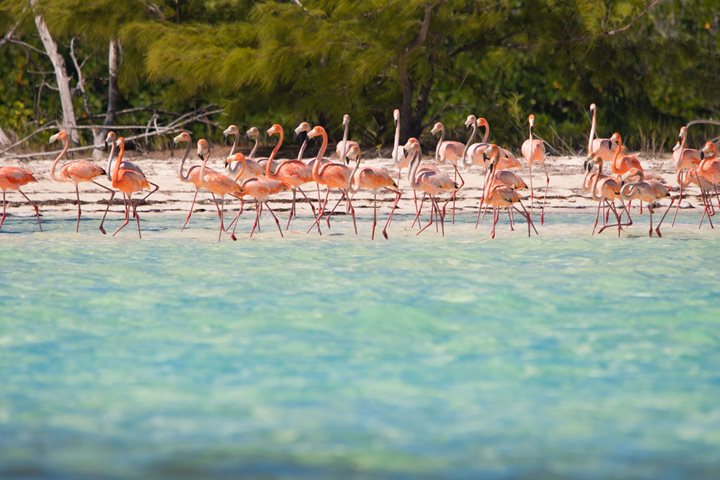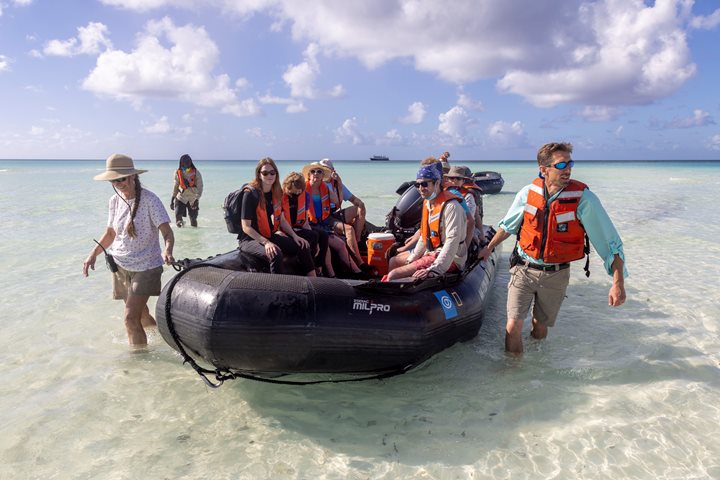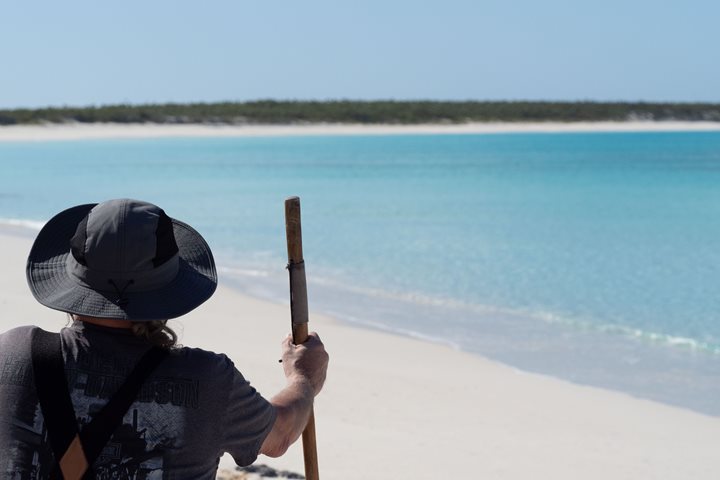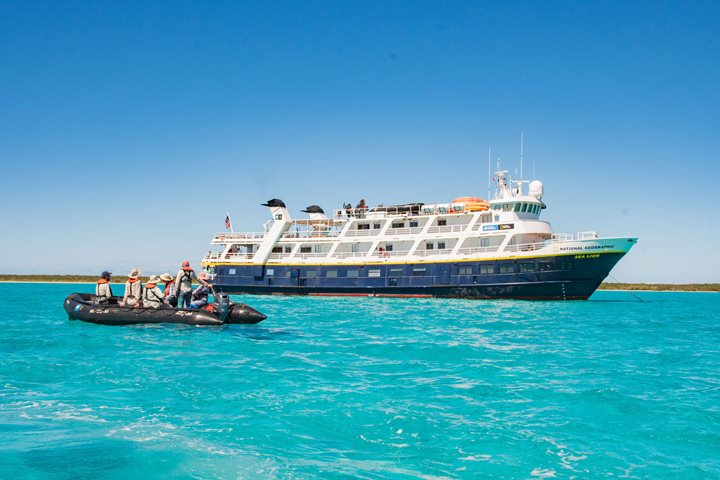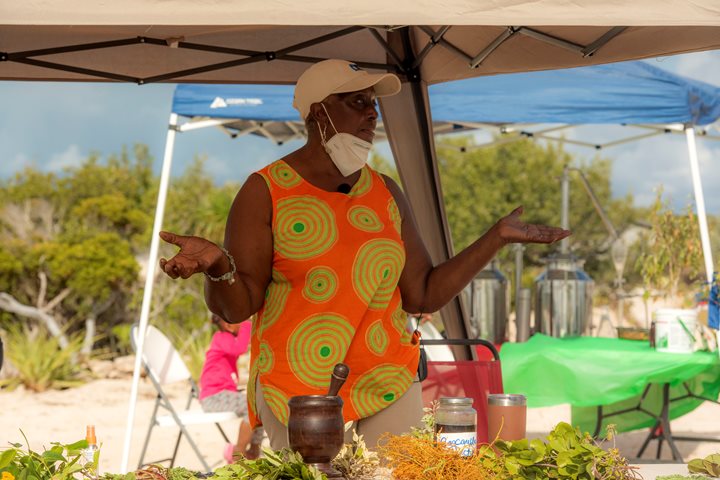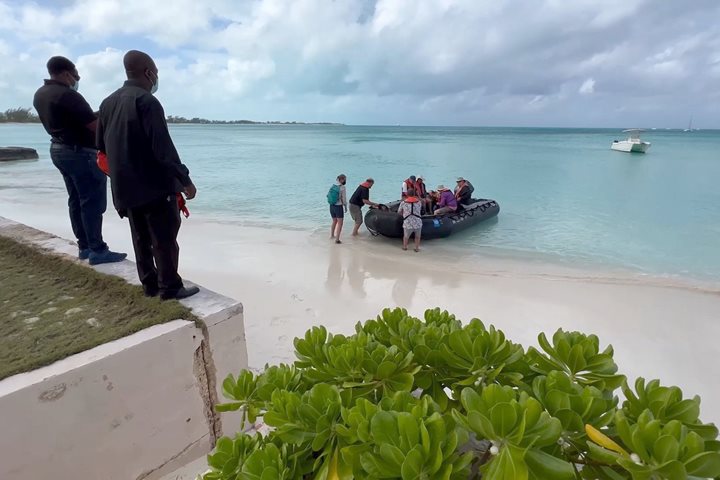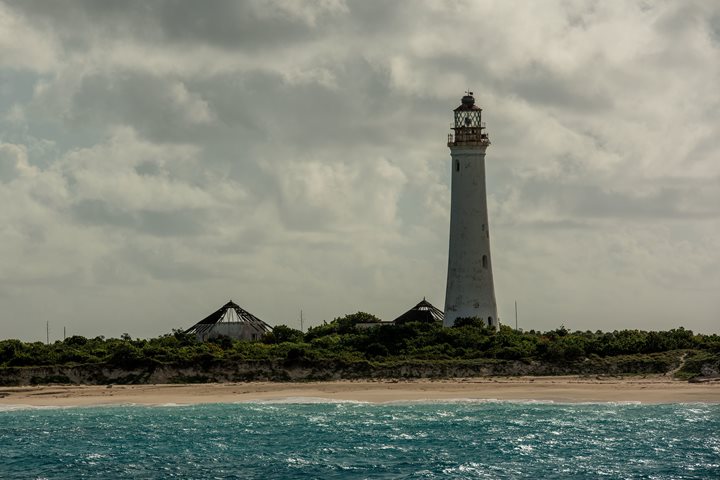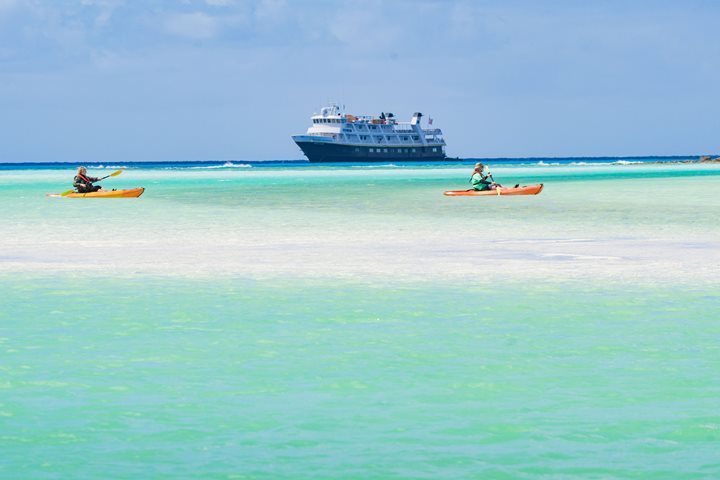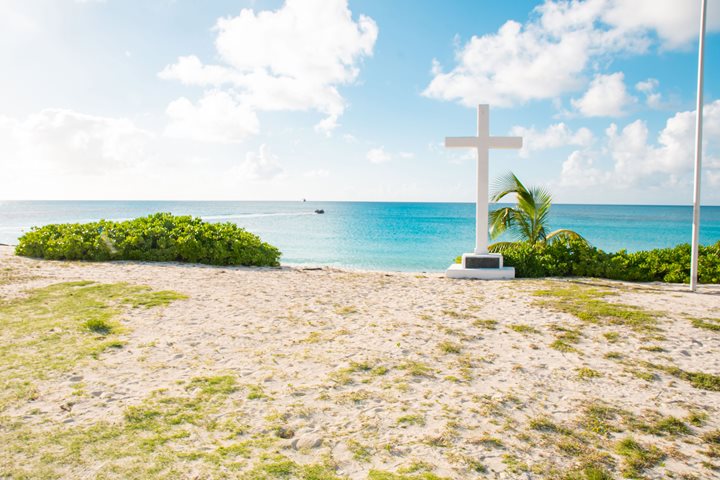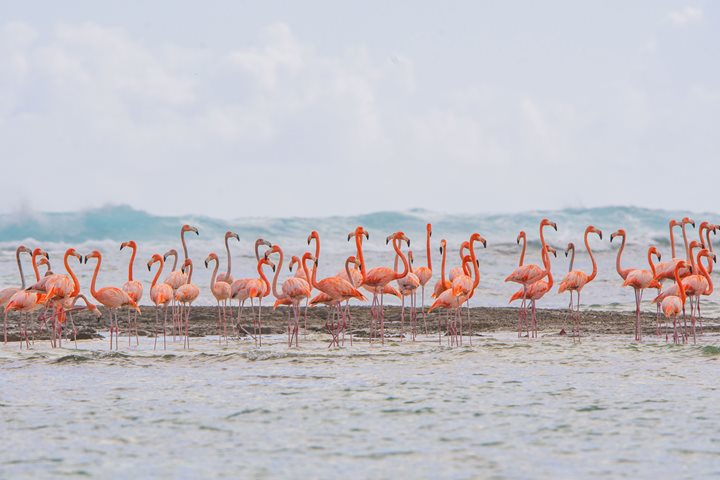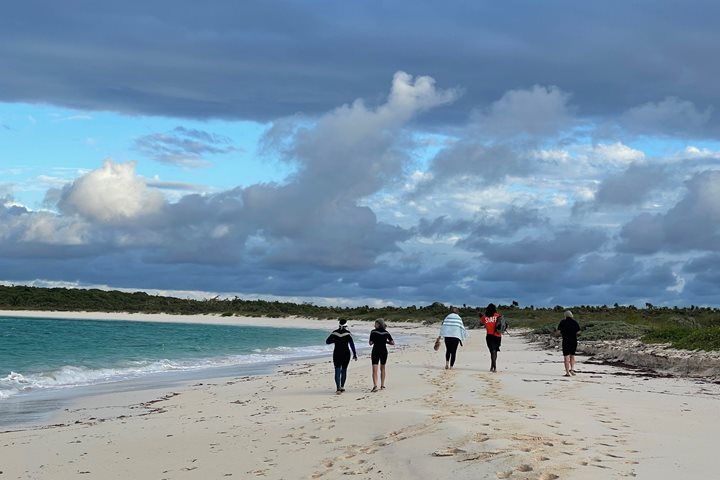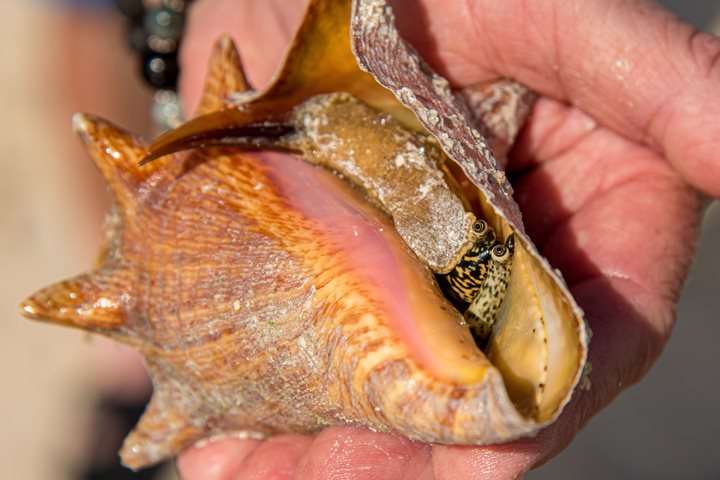Call +1.800.397.3348 or contact your travel advisor
Expedition Stories
Our fleet navigates the world in search of adventure. These are the stories they bring back…
Loading...
Loading...
Previous Reports
2/21/2022
Read
National Geographic Sea Lion
Crooked Island and Long Cay, Bahamas
Welcome to the Ephemeral Isles. Early this morning, National Geographic Sea Lion approached Crooked Island in the southern Bahamas. We were greeted by a graceful sunrise, marking the beginning of Lindblad’s first ever expedition to the Bahamas. This inaugural expedition seeks to explore the rich natural history, culture and landscape of the remote, pristine southern islands of the Bahamas. Even though these chains of islands are only a short distance from the coast of Florida, this is the first time a Lindblad ship has ever explored these waters, making this a true ‘expedition’ for all the guests, staff and crew on board. After a long, rocky crossing from Exuma to Crooked Island, we dropped our anchor off the southern coast and got ready to embark on this new adventure. For our first adventure, we set out on Zodiacs to explore Long Cay and get our first look at these beautiful islands. We were also looking for a very special bird, the West Indian flamingo. The flamingo is the national bird of the Bahamas, and they are reliably seen only on the southern islands of the Bahamas. We had pretty good knowledge and a record of a small flock that frequents the eastern side of Long Cay. After about a 30-minute ride across the sea and onto the Bight of Acklins, we scanned the shoreline of Long Cay until we spotted some hints of pink. Indeed, we spotted about 20 flamingos at first. Another flock joined them later, increasing the number of birds to about 60. We observed these majestic birds in their natural habitat for about 20 minutes. After this, we headed back to National Geographic Sea Lion to have lunch and then prepare for more adventures. In the afternoon, we headed to a pristine white sand beach on the end of Crooked Island and split into groups. These groups included kayaking and snorkeling. While kayaking, we explored a picturesque mangrove creek that went up into the interior of Crooked Island. There we observed green sea turtles, queen conch, a southern stingray and a few species of native birds. This was our introduction to the magnificence and biodiversity of mangrove creeks in the Bahamas. We kicked off day one of this historic itinerary with a great start, seeing several iconic Bahamian species and getting a sense of the wonder that is the Bahamian tropics. Each day this week, we will explore a different part of paradise, uncovering more discoveries and breathtaking adventures.
2/23/2022
Read
National Geographic Sea Lion
Long Island, The Bahamas
We woke up this morning crossing between Atkins Island and Long Island in choppy seas. We started our daily activities on the southwestern point of the aptly named Long Island with kayaking, stand up paddle boarding, a natural history walk, and a photo walk. Afterwards we took a relaxing swim or lounged on the supremely beautiful white sandy beach that is typical of the Bahamas.
2/25/2022
Read
National Geographic Sea Lion
Conception Island National Park, The Bahamas
We had such a successful scouting experience on Conception Island yesterday that we decided there was too much to do in one day. The easiest solution was to spend two days here to fit everything in! We started today with an early riser beach walk for wildlife and bird sightings that departed for the beach as the sun made its way over the horizon. Those of us that are a bit more attached to our pillows in the morning departed for the beach later in the morning to join with the group and go for a long walk to the other side of the island. We crossed the plant-covered dunes and found ourselves on another stretch of white sandy beach with the wind blowing in our faces and waves crashing onto shore. As we made our way to the other end, we climbed up some beautiful bluffs to get a better look at all the patch reefs and the Atlantic Ocean stretching out endlessly to the east. We decided to adventure further along the bluffs, exploring the plethora of plants and flock of intrepid mockingbirds. When we eventually made our way back to our landing beach, the water was so crystal clear that none of us could resist a rewarding swim to cool off as we awaited our rides back to the ship. In the afternoon we returned to Conception Island one final time to continue our underwater exploration by snorkeling in another area of patch reefs.
2/28/2022
Read
National Geographic Sea Lion
Long Cay, the Bahamas
Lindblad’s historic inaugural expedition to the Bahamas last week has come and gone. We have fueled up, onboarded new guests, and embarked on our second week of exploring these wonderful, fragile islands. This second week will bring new adventures and discoveries as we continue to add new spots and destinations to our voyage. Just like week one, our first stop for week two was Long Cay on the Bight of Acklins. With much better weather conditions, we were able to anchor on the southeastern side of Long Cay, which means we were much closer to the areas we wanted to explore. After we dropped anchor, we had several briefings onboard, including our Zodiac safety briefing. Our first activity was to get in our Zodiacs and make our way up the island as we scanned the coast for the small resident flock of flamingos. Fifteen minutes into our Zodiac ride, we spotted a small group of flamingos (called a flamboyance) flying in and landing along the coast. Their bright, vibrant pink plumage stood out amongst the calm, azure, crystal clear waters. We were able to get close to the flock of birds without scaring them off. After a lot of whispers about the conservation story of these birds and hundreds of camera shutter clicks, we started our engines again and headed back to National Geographic Sea Lion . After returning to the ship, we enjoyed a quick presentation by Aaron Raymond on, “Photography Basics and Techniques.” After lunch, we got briefed and fitted for our first snorkeling adventure in the afternoon. During this time, we lifted anchor and repositioned National Geographic Sea Lion to the west coast of the island, where there are more coral reefs. Our afternoon snorkel spot was a shallow coral reef that ran parallel to an incredibly beautiful and picturesque beach. This beach, like many others in the Southern Bahamas, probably has not seen human foot traffic in years. We settled there for the afternoon to use our snorkel gear for the first time this trip. We were eager to give our guests their first look at a Bahamian coral reef and the threats they face. After our afternoon beach hang and snorkel, we returned to National Geographic Sea Lion to end our first day in paradise. The calm seas and almost cloudless skies gifted us with a picture-perfect sunset that painted the skies in different shades of red and orange. After we enjoyed this graceful moment, we had dinner and came together to talk about national parks and conservation efforts in the Bahamas.
3/2/2022
Read
National Geographic Sea Lion
Acklins Island
National Geographic Sea Lion finished a calm crossing from Mayaguana Island, heading slightly north toward Acklins Island. Our captain had the ship anchored by 6:00 a.m. as the sun was beginning to show first light. Our clear and calm conditions were beginning to change. As some of us made our way up on deck, we observed clouds beginning to form in the northern part of the sky. We were anchored off the northern tip of Acklins Island in the protected waters of Atwood Harbor. Acklins Island is one of only two islands in the Bahamas where cascarilla bark grows. This bitter herb is the key ingredient used to make Campari liquor. As our Zodiacs pulled up to a rocky landing, a wonderful group of locals greeted us. Acklins Island is not on the main tourist route of the Bahamas. For locals, the arrival of a small ship with guests was something to celebrate! Our host, Anita Collie Verdecia, a local ethnobotanist and herbalist, began a presentation on bush medicine. She stood behind a large table covered by a variety of plants that she uses as medicine. She shared stories about bush medicine and how she had gained her knowledge. She then introduced Mrs. Patricia Hanna Cleare, who spoke about Acklins’ slave trade and the slave plantations on the island. Our final speaker brought all of his distilling equipment and explained how he extracts both essential oils and a hydrosol from cascarilla bark. We then had a chance to wander through the displays and ask questions about life on this extremely remote Bahamian island. Once everyone finished talking with our local hosts, we were invited to board National Geographic Sea Lion’s Zodiacs for a tour through a nearby mangrove river system. The “river” is a series of saltwater channels where mangroves grow in the dense forest. The tide was falling, so our ride was a careful meander through a mangrove forest with channels of saltwater that were rich in life! Rays, turtles, and schools of fish were everywhere…a wonderful way to finish our morning at the northern end of Acklins Island. After lunch, we returned to the same saltwater channels for kayaking and swimming! As the afternoon light began moving west, we enjoyed a relaxing paddle and swim in the protected waters of Atwood Harbor. Once back onboard and refreshed, we met in the forward lounge for cocktails and recap. Then, we were offered a lovely invitation to the sundeck for dinner. The last light of day was fading as we sat down to our tables and enjoyed another lovely meal provided by the galley of National Geographic Sea Lion .
3/5/2022
Read
National Geographic Sea Lion
Long Island, the Bahamas
On our last day of week two of our new Bahamas Expedition, we woke along the northern coast of Long Island. We spent our morning here exploring features and places on shore. First, we hiked up to the highest point on the island. We visited a monument that honors the original inhabitants of the Bahamas, the Lucayans, and the arrival of Christopher Columbus to Long Island in 1492(3). Before moving to our next spot, we made a stop at some nearby gift shops to view and purchase arts and crafts made by locals. Afterwards, we took another hike up to the Adderley Monument and Plantation. The plantation was built around 1790 and consisted of cotton and livestock, including sheep, goats, and horses for work and transport. Once we felt like we had enough adventure for the day, we enjoyed lunch at a local restaurant on the coast. Then we headed back to National Geographic Sea Lion to pull up the anchor and be on our merry way.
2/22/2022
Read
National Geographic Sea Lion
Acklins Island, Bahamas
National Geographic Sea Lion made an early morning crossing from Long Cay on Crooked Island, heading south toward our morning destination of Castle Island. Windy conditions prevented a landing, however, so off we went to Acklins Island, where we spent the remainder of the day. Once National Geographic Sea Lion anchored, preparations were made to take the full complement of the ship to shore. Members of the community of Salina Point Settlement greeted us on the beach! As Zodiacs approached, the beach musicians began drumming and singing. The sound brought out the dance in many of us! Once everyone made it ashore, we gathered a short distance up the beach for a series of presentations and speeches from local community members. Anita Collie Verdecia, a local ethnobotanist and herbalist, was our main host. She introduced each speaker before speaking at length about the bush, explaining how medicine has been obtained from many plants in this tropical part of the world. We also heard from Mrs. Patricia Hanna Cleare on the slave trade and slave plantations on Acklins Island. The former commissioner of the Royal Bahamas Police Force, Mr. Reginald Fergusan, is a known local historian. He spoke about the settling of this area and its original inhabitants. The speakers talked about their lives on Acklins Island, and they were very grateful for our visit. This remote island is not on the regular tourist route in the Bahamas. We arrived on a good-sized ship and wanted to come ashore to safely interact with the people of Salina Point Settlement. We were met with such a welcome and joyous response. We were fortunate to share a few hours together in the late afternoon of an auspicious day. Today is a very unusual and rare day in our calendar. February 22, 2022 is one of only seven dates to contain a palindrome this century. A palindrome is a word or a set of numbers that reads the same way backward and forward. The date and day also mark a time for equilibrium and balance. Looking forward, the need to value these attributes is critically important. So our afternoon came to a close. We made our way back to National Geographic Sea Lion by Zodiac. We were ready to spend time relaxing, and we enjoyed reflecting on our good fortune. We were grateful that the lovely and gracious community of Salina Point Settlement offered us such a warm welcome. Our hotel staff decided to serve dinner on the sun deck, as the colors of twilight filled the sky. We all made our way topside and enjoyed another lovely meal prepared by the galley.
2/24/2022
Read
National Geographic Sea Lion
Conception Island National Park, The Bahamas
Today we woke up to a slow, steady cruise as we approached a very special island in The Bahamas. After great anticipation by staff and guests, Conception Island was finally within close sight off the bow of National Geographic Sea Lion . Conception Island is situated within the Conception Island National Park, one of the 32 national parks in The Bahamas managed by The Bahamas National Trust. I’ve been to most of the major islands in The Bahamas, and hundreds of little cays throughout the archipelago, and all these islands have their own unique features. However, I regard Conception Island as the most spectacular island in The Bahamas and the jewel in our national park system. This island represents what The Bahamas looked like before industrialization and human habitation. Sitting on its own underwater platform isolated in thousands of feet of water, this island was never connected to any other island in the Lucayan Sea. As we dropped our anchor in the sandy bottom that surrounds the island, we were greeted by two curious bottlenose dolphins in the water below and a flock of tropic birds singing and gracing the skies above. This was the first time we’ve seen both of these species for the week. This was a feel good moment, and this was a sign that today was going to be a great one. We wanted to get going as soon as we could, so we prepared for the first round of activities. One of the main natural features on Conception Island is a large mangrove creek on the southwestern side of the island. This shallow water creek is lined with red mangroves and shallow sand bars, making it great for exploration. We started our Conception Island adventure with kayaking, stand-up paddleboarding, and Zodiac tours in this creek. We encountered an amazing amount of wildlife, especially young green turtles. We also saw southern stingrays, spotted eagle rays, lemon sharks, and various species of birds including the endangered Piping plover, which spends its winters in The Bahamas. We were all thrilled by the incredible amount of biodiversity in the creek. Afterwards we headed back to National Geographic Sea Lion for lunch with smiles on our face. In the afternoon, we headed further north along the island to have our first real coral reef snorkeling experience. Conception Island is surrounded by healthy patch reefs that touch the surface of the clear, turquoise shallow water. During our snorkel we saw many different reef fish species, hard and soft corals, southern stingrays, and even nurse sharks. Snorkeling was perhaps the biggest thing that most of the guests and staff were looking forward to on this expedition. Conception Island National Park surely lived up to all of the excitement and expectations that I created for it days before we even got here. It was all so good that we decided to stay put for the rest of the evening and night and spend the next full day here.
2/26/2022
Read
National Geographic Sea Lion
San Salvador, Bahamas
In the early 15th century when Christopher Columbus made his historic journey across the oceans to discover the new world, he made stops at several destinations. For decades, where he landed first has been debated. Most historians, and strong evidence and research, points to the island of San Salvador as the first place Columbus landed. More specifically Long Bay, on the western coast of San Salvador. Like true explorers, we also anchored National Geographic Sea Lion off the western coast of San Salvador and made landfall on Long Bay. For our last day of this historic Lindblad expedition, we wanted to explore the history and culture of this beautiful island. There are five national parks on San Salvador that protect critically important habitats, species, and spaces on the island. We originally planned on dropping anchor near Graham’s Harbour Seabird and Iguana National Park to take a Zodiac tour around the small cays to see the namesake species of the park; however the weather today made this impossible. We decided to shift gears and head further south, along the west coast, to spend the entire day hunkered down in the West Coast Marine National Park. Among other things, this 10,000-acre national park protects some of the most dramatic and breathtaking coral reef wall formations in The Bahamas, which are world renowned for scuba diving. It also protects other shallow coral reefs and several bay areas, including Long Bay. In the morning, we snorkeled the extensive reefs that are only a few hundred feet from shore. We were able to see these incredible reef structures, the wildlife that inhabit them, and also got a good look at some of the issues that coral reefs face like disease and pollution. After heading back to the ship for lunch, we returned to Long Bay for an afternoon on the coast. We were greeted by J. Johnson, local senior tourism executive who shared an in-depth perspective of the rich natural and cultural history of San Salvador. Afterwards, we viewed the several monuments that are on Long Bay and in the “Landfall Park” including the primary monument erected at the area believed to be where Columbus came ashore, and statues commemorating the 400th and 500th anniversary of the landing. Among the Columbus Landfall monuments there is also a large monument built to receive the Olympic Flame on September 1968.
3/1/2022
Read
National Geographic Sea Lion
Mayaguana
Heading toward a new addition to our Bahamas itinerary, we woke up this morning near Mayaguana, the easternmost island in the Bahama archipelago. Not very popular for tourism, Mayaguana remains one of the most pristine and untouched islands in the Bahamas. Because this was a new destination for us, our field staff team went out early to scout exciting areas for adventure. We drove all along the southwestern coast, stopping at several places that piqued our interest. On the eastern tip of Pirates Well, we saw a small flock of flamingos, about 30 birds, on the outer fringe of a mangrove creek. I had some expectations for spotting these birds here, as I have documented them in this same spot several times in the past. On our way back to National Geographic Sea Lion , we saw another small flock of birds flying toward the first group. We knew right away that the flock was getting larger. We wanted our guests to have the chance to see a flamboyance twice the size as the one we encountered yesterday. 45 minutes later, we were back in three Zodiacs with cameras, binoculars, and spotting scopes to get a closer, better look at the flamingos. We spent about 30 minutes with these birds before cruising along the sand flats closer to shore. As in many coves and flats in the Bahamas, the water level between high and low tide can determine whether you spend a few minutes in a spot and make it home, or end up deserted for several hours. After we spent enough time with the flamingos, we headed inshore to explore some of the coastal forests and mangrove creeks. On our way across the flats, we were surprised to see many different critters, including a huge southern stingray, green sea turtles, and many juvenile queen conchs. The queen conch is an iconic species in the Bahamas, so I took a moment to talk to guests about this important marine gastropod and its plight. We eventually made our way back to National Geographic Sea Lion for lunch, and we repositioned farther along the east coast toward a different spot. We spent the afternoon kayaking and paddling along the coast. We explored seagrass beds, patch reefs, and rocky, sandy shores in the area. We saw various species of fish, birds, and some sea turtles. We ended our day here and headed back to the ship. Our next stop tomorrow: Acklins Island.
3/4/2022
Read
National Geographic Sea Lion
Conception Island
After a detour to Great Exuma, we returned to Conception Island to experience what some people consider to be the premier national park in the Bahamas. The whole island is a 2600-acre park, but the underwater part of the park increases the protected area to 30,000 acres. In the morning, we took a Zodiac tour in the mangrove lagoons, where we learned about mangroves, turtles, queen conches, and rays. Next we went kayaking and standup paddleboarding in a part of the lagoon that is too shallow for the Zodiacs. After lunch, the weather was quite bad, but it improved rapidly. We were still able to snorkel on a beautiful coral reef and take a walk on a gorgeous beach.
3/7/2022
Read
National Geographic Sea Lion
Stocking Island, The Exumas
Today marked new experiences for us all: avoiding some nasty weather, we explored somewhere none of us had been before, a place called Stocking Island. I haven’t been this impressed with a brand-new landing site in a long time. It quickly became a favorite of the staff aboard National Geographic Sea Lion , and I truly hope we’ll return here on future trips.
Showing 12 of 57

